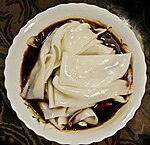
Cantonese or Guangdong cuisine, also known as Yue cuisine is the cuisine of Guangdong province of China, particularly the provincial capital Guangzhou, and the surrounding regions in the Pearl River Delta including Hong Kong and Macau. Strictly speaking, Cantonese cuisine is the cuisine of Guangzhou or of Cantonese speakers, but it often includes the cooking styles of all the speakers of Yue Chinese languages in Guangdong.
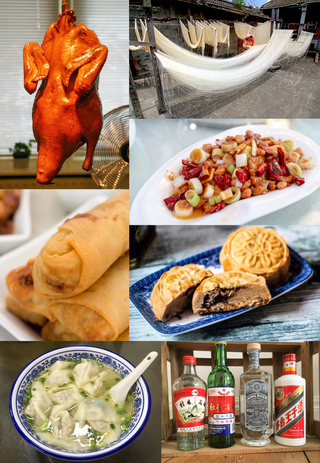
Chinese cuisine comprise cuisines originating from China. Because of the Chinese diaspora and historical power of the country, Chinese cuisine has profoundly influenced many other cuisines in Asia and beyond, with modifications made to cater to local palates. Chinese food staples such as rice, soy sauce, noodles, tea, chili oil, and tofu, and utensils such as chopsticks and the wok, can now be found worldwide.

Shanghai cuisine, also known as Hu cuisine, is a popular style of Chinese food. In a narrow sense, Shanghai cuisine refers only to what is traditionally called Benbang cuisine which originated in Shanghai. In a broader sense, it refers to complex styles of cooking developed under the influence of neighboring Jiangsu and Zhejiang provinces.

Offal, also called variety meats, pluck or organ meats, is the internal organs of a butchered animal. The word does not refer to a particular list of edible organs, and these lists of organs vary with culture and region, but usually exclude skeletal muscle. Offal may also refer to the by-products of milled grains, such as corn or wheat.
Sweet and sour is a generic term that encompasses many styles of sauce, cuisine and cooking methods. It is commonly used in East Asia and Southeast Asia, and has been used in England since the Middle Ages. Sweet and sour sauce remains popular in Asian and Western cuisines.

Northeastern Chinese cuisine is a style of Chinese cuisine in Northeast China. While many dishes originated from Shandong cuisine and Manchu cuisine, it is also influenced by the cuisines of Russia, Beijing, Mongolia, and North Korea. It partially relies on preserved foods and large portions due to the region's harsh winters and relatively short growing seasons.

Chinese Indonesian cuisine is characterized by the mixture of Chinese with local Indonesian style. Chinese Indonesians, mostly descendant of Han ethnic Hokkien and Hakka speakers, brought their legacy of Chinese cuisine, and modified some of the dishes with the addition of Indonesian ingredients, such as kecap manis, palm sugar, peanut sauce, chili, santan and local spices to form a hybrid Chinese-Indonesian cuisine. Some of the dishes and cakes share the same style as in Malaysia and Singapore, known as Nyonya cuisine by the Peranakan.

Korean–Chinese cuisine, also known as Sino–Korean cuisine, is a hybrid cuisine developed by the ethnic Chinese in Korea.

Japanese Chinese cuisine, also known as Chūka, represents a unique fusion of Japanese and Chinese culinary traditions that have evolved over the late 19th century and more recent times. This style, served predominantly by Chinese restaurants in Japan, stands distinct from the "authentic Chinese food" found in areas such as Yokohama Chinatown. Despite this difference, the cuisine retains strong influences from various Chinese culinary styles, as seen in the Shippoku cooking style.
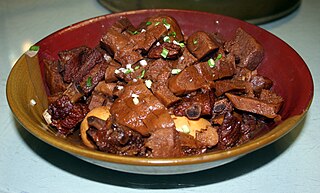
Shandong cuisine, more commonly known in Chinese as Lu cuisine, is one of the Eight Culinary Traditions of Chinese cuisine and one of the Four Great Traditions. It is derived from the native cooking style of Shandong Province, a northern coastal province of China.

Huaiyang or Jianghuai cuisine is one of the Four Great Traditions in Chinese cuisine. It is derived from the native cooking styles of the region surrounding the lower reaches of the Huai and Yangtze rivers and centered on the cities of Huai'an, Yangzhou and Zhenjiang in Jiangsu Province. Although it is one of several sub-regional styles within Jiangsu cuisine, Huaiyang cuisine is widely seen in Chinese culinary circles as the most popular and prestigious style of Jiangsu cuisine – to a point where it is considered to be one of the Four Great Traditions that dominate the culinary heritage of China, along with Cantonese cuisine, Shandong cuisine and Sichuan cuisine.
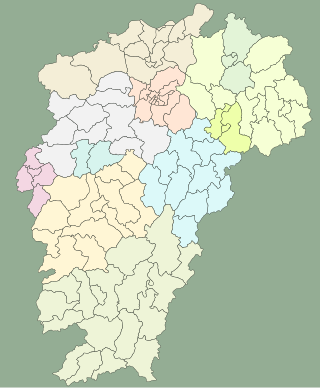
Jiangxi cuisine, also known as Gan cuisine, is a style of Chinese cuisine derived from the native cooking styles of Jiangxi province in southern China. According to the East China Travel Guide published in 1983, Jiangxi Cuisine has its unique taste which can be described in four Chinese idioms: 原汁原味(aim to bring out the own flavor of the cooking material),油厚不腻(dishes contained a significant amount of oil but the taste are not greasy),口味浓厚(dishes have really thick taste),咸鲜兼辣(always come with spicy solid, salty flavor). Jiangxi cuisine is widely popular within the ordinary family because most of the notable dishes from Jiangxi cuisine are the extension of homely dishes with solid local flavor.

Shaanxi cuisine, or Qin cuisine, is derived from the native cooking styles of Shaanxi Province and parts of northwestern China.

Lor mee is a Chinese Hokkien noodle dish from Zhangzhou served in a thick starchy gravy. Variants of the dish are also eaten by Hokkiens in Singapore, Indonesia, Malaysia and Thailand. In the Philippines, the local variant is called Lomi or Pancit Lomi. The thick gravy is made of corn starch, spices, meat, seafoods and eggs. The ingredients added into the noodles are usually ngo hiang, fish cake, fish, round and flat meat dumplings, half a boiled egg, and other items depending on the stall and the price paid. Vinegar and garlic can be added as an optional item. Lor Mee can be served together with red chili. Traditional versions also include bits of fried fish as topping though few stalls serve this version anymore.
Black vinegar is dark-colored vinegar used in Chinese cuisine.

Pork blood soup is a soup that uses pork blood as its primary ingredient. Additional ingredients may include barley and herbs such as marjoram, as well as other foods and seasonings. Some versions are prepared with coagulated pork blood and other coagulated pork offal, such as intestine, liver and heart.

Sabahan cuisine is a regional cuisine of Malaysia. As in the rest of Malaysian cuisine, Sabah food is based on staples such as rice with a great variety of other ingredients and different methods of food preparations due to the influence of the state's varied geography and indigenous cultures that were quite distinct from the regional cuisines of the Peninsular Malaysia. Sabah along with its neighbour of Sarawak is famous for their multi-ethnic population.
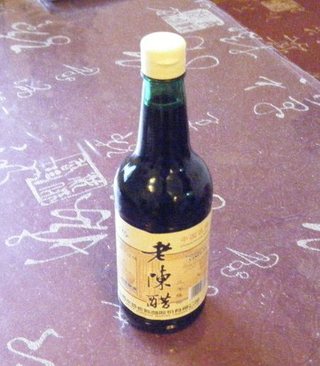
Shanxi Mature Vinegar is a type of Chinese vinegar. It is special product of Shanxi Province, a product of China's National Geographical Indication.





